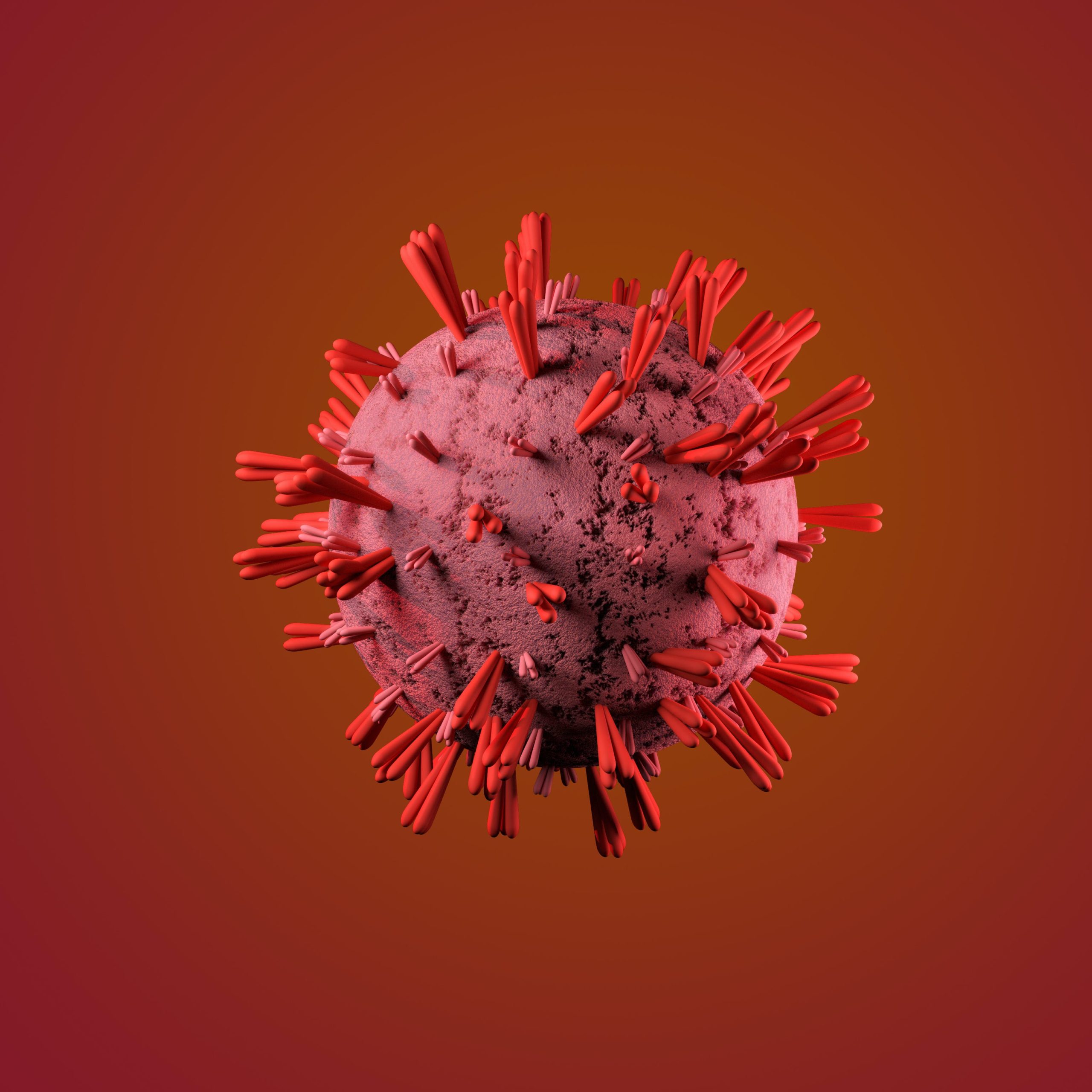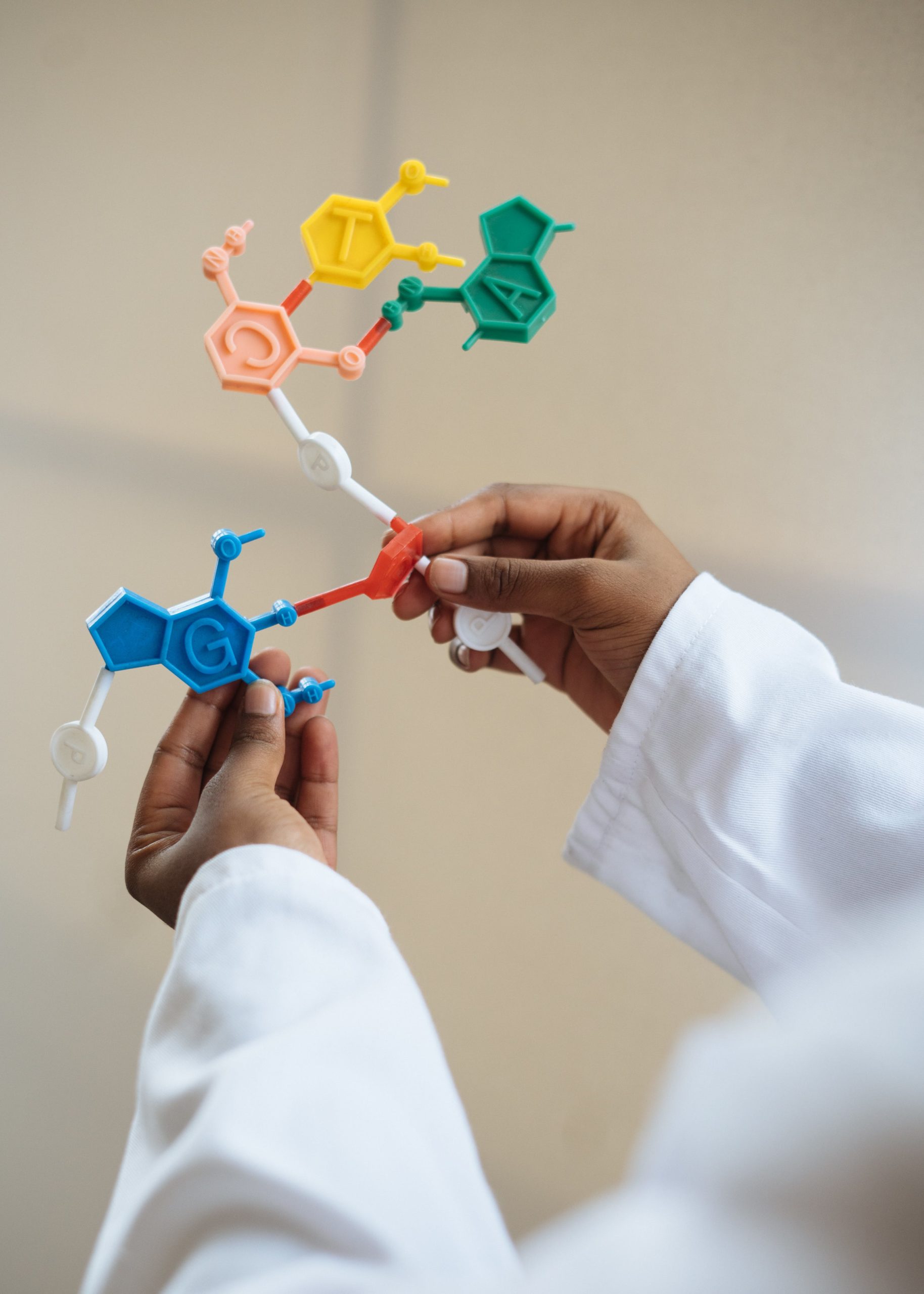Understand your DNA through genetic testing.
With an analysis of your genes, you can customize your health choices exactly according to your genetic code, taking control of your own health and well-being.
What is DNA?
DNA, or deoxyribonucleic acid, serves as our genetic blueprint. While most of the DNA is located in the cell nucleus within chromosomes (known as nuclear DNA or nDNA), a small amount is also found in the mitochondria (referred to as mitochondrial DNA or mtDNA).
 Bases
Bases
DNA information is encoded using four chemical bases:
- Adenine (A)
- Guanine (G)
- Cytosine (C)
- Tymin (T)
Base pair
These bases form pairs to form devices:
- Adenine (A) pairs with thymine (T)
- Cytosine (C) pairs with Guanine (G)
Nucleotide
A nucleotide consists of a base, a sugar unit and a phosphate group. Nucleotides bind together in base pairs and arrange themselves into two long strands that form a double helix structure.
Genes
Genes, composed of DNA, act as templates for protein synthesis. In humans, genes vary in size from a few hundred to over 2 million base pairs. Each gene exists in two copies, inherited from each parent.
SNP (single nucleotide polymorphism)
SNPs represent variable nucleotides at specific positions in the genome and are not considered mutations. Approximately 99.9% of human DNA is consistent across all individuals, with SNPs occurring, on average, once every 300 nucleotides. SNPs can act as biological indicators, suggesting a predisposition to certain behaviors or physical traits.
Alleler
An allele, derived from "allelomorph" meaning "different form", denotes one of several alternative forms of a specific point within a gene. At a given SNP position, two possible inherited alleles exist, one from each parent. While SNPs indicate the position of altered bases, alleles refer to single bases within a base pair. For example, a T allele indicates that the base referred to within the altered base pair is thymine.
Genotype
The genotype represents the combination of two alleles inherited (genetic material) from each parent at a given SNP position.
Chromosomes
Chromosomes are microscopic structures that resemble fingers and contain tightly packed DNA. Under normal conditions, humans have 23 pairs of chromosomes.
What is DNA health?
DNA health is about optimizing health, energy and wellbeing while preventing disease by making better lifestyle and dietary choices and using customized supplements to counteract specific nutritional deficiencies or genetic weaknesses. The DNA health approach establishes the optimal nutrition necessary for good health, energy and longevity.
There is a wealth of isolated genetic tests, but DNA health tests as many as 60 gene variations that are involved in key biological processes that control health and disease:
- Lipid metabolism
- Methylation
- Detoxification
- Oxidative stress
- Inflammation
- Insulin resistance
- bone health
- Response to food
- Gluten intolerance
- Vitamin metabolism
Many diseases can be prevented through proper diet and lifestyle choices. DNA health is designed to help healthcare professionals support their patients to make the best diet and lifestyle choices based on their unique DNA.
Lipid metabolism
Atherosclerotic and thrombotic conditions affecting the cardiovascular system are leading causes of mortality and morbidity. Significant advances in the understanding of environmental factors contributing to complex cardiovascular diseases have led to significant public health initiatives aimed at changing lifestyle and dietary habits.
Nutrition is widely recognized as a crucial factor in the prevention of cardiovascular diseases. Within nutritional considerations, total fat intake and different types of fat have been extensively studied.
Different types of fatty acids have different effects on lipid metabolism, metabolic risk factors and vulnerability to cardiovascular disease. However, these effects can be influenced by genetic variations that affect fatty acid metabolism.
Single gene defects are present in a relatively small proportion (5-10%) of individuals at high risk of premature coronary heart disease, while multiple gene variations with minor effects contribute to cardiovascular disease risk in the majority of people. Such polygenic effects are largely influenced by environmental factors, suggesting that most cases of premature cardiovascular death can be prevented by addressing or modifying external factors that may exacerbate a genetic predisposition.
Methylation
DNA methylation is the process of donating 'methyl groups' to a substrate. A methyl group consists of one carbon bonded to three hydrogen atoms (CH3).
Substrates for methyl groups include DNA and RNA, chemicals, neurotransmitters and hormones, as well as immune cells, etc. Methylation has several functions, such as gene regulation, biotransformation (or processing of chemicals and toxins), myelination (production of the protective coating on nerves), formation of neurotransmitters and immune cells, processing of hormones, and DNA and RNA synthesis. Methylation is regulated by enzymes and substrate (end product), and many enzymes require cofactors, often derived from vitamins and minerals, to be activated.
B vitamins provide building blocks for growing cells, which are constantly renewed, and play an important role in many physiological processes. B vitamins also provide some of the chemicals necessary to protect our genes so that our DNA does not accumulate damage from the wear and tear of the daily lives of our cells.
These vitamins - including folate, vitamin B6 and B12 - help create new DNA for cells that are constantly growing and renewing themselves.
Folic acid is also involved in switching many genes on and off, and also helps with DNA repair. Although B vitamins are only needed in small amounts, they are essential for methylation and the production of new DNA.
Folic acid is a water-soluble vitamin classified as part of the B vitamin group. Because it is water-soluble, its content is significantly reduced when cooked; processing whole grain wheat into flour, for example, removes 68% of its folate content. It has been estimated that only about 20-25% of the folate content in food is biologically available.
Low levels of folate and SNPs involved in the methylation process are associated with increased risk of hyperhomocysteinemia, as well as higher levels of DNA adducts, and with risk of cardiovascular disease, certain cancers and neural tube defects.
If several gene variants in this group carry moderate to high risk, it may be prudent to assess a person's methylation profile at the biochemical level. This provides insight into actual metabolites in the methylation pathway. Methionine, S-adenosylmethionine (SAM), S-adenosylhomocysteine (SAH), homocysteine as well as cysteine and cystathionine, metabolites in the trans-sulfuration pathway and precursors to glutathione.
Detoxification
The body's detoxification process has two phases. The enzymes involved in phase one detoxification are called 'activating enzymes'; they activate the substance that needs to be removed, thus allowing the next phase to proceed. Phase I enzymes must show just the right amount of activity for the detoxification process to be effective. Activated compounds in phase I can potentially be harmful.
The enzymes that take over after phase I are called 'excretors' because they catalyze reactions that lead to the excretion of toxins from the body. These enzymes bind the chemical compound glutathione to 'active' phase I toxins, making them water-soluble so they can be excreted through sweat or urine. Reduced activity or deletion of these genes has been associated with cancer and other diseases.
Chronic inflammation / Inflammation
Chronic inflammation is a prolonged low-grade inflammatory reaction triggered by persistent stimuli in the tissue. This leads to tissue damage while the body attempts to heal and repair. The extent and duration of chronic inflammation varies depending on the balance between the triggering cause and the body's efforts to remove it. Factors such as age, nutritional deficiencies (including vitamins C, protein, zinc and fatty acids), metabolic diseases and certain medications can affect the healing process. Gene polymorphisms that cause elevated levels of pro-inflammatory agents have been identified. Nutritional and lifestyle interventions aim to either directly affect gene expression to reduce cytokine levels or to address secondary aspects of the inflammatory response.

Oxidative stress
Oxidative stress occurs as a result of the body's energy-producing biochemical processes generating free radicals. These free radicals are highly reactive with other molecules and can damage DNA, proteins and cell membranes. The balance between oxidation and antioxidation is thought to be crucial for maintaining healthy biological systems. Dietary antioxidants, such as vitamin C, vitamin E, carotenoids and polyphenols, are free radical scavengers that react with the free radicals to ensure they are no longer reactive molecules. These antioxidants play an important role in many antioxidant mechanisms in living organisms. However, the bulk of antioxidant defense is taken care of by the body's own antioxidant enzymes.
bone health
Osteoporosis is a complex disease characterized by reduced bone mass, degradation of bone tissue and increased risk of fractures. Family and twin studies have established a strong genetic contribution to the cause of osteoporosis, and 60-70% of the variation in bone mineral mass or bone mineral density (BMD) can be attributed to genetic and dietary variation.
The following categories of contributing genes have been identified: calcium homeostasis, hormonal dysfunction, development and regulation of osteoblasts and osteoclasts, cartilage matrix degradation and lipoprotein metabolism. Polymorphisms of the vitamin D receptor have been linked to bone mass in several studies, and there is evidence that this association can be modified by dietary intake of calcium and vitamin D.
Other genetic self-tests we offer are:
DNA Sport
DNA Mind
DNA Estrogen
Read more about our genetic testing here: DNA Testing



